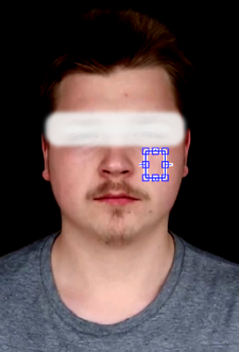Cardiointervalogram determination from video sequence of human face
DOI:
https://doi.org/10.3103/S0735272724080028Keywords:
remote photoplethysmography, face video, pulse signal, region of interest, color trace, heart rate, cardiointervalogram, heart rate variabilityAbstract
The process of obtaining human pulse signals in the remote photoplethysmography system has been developed. The procedure is based on the use of a video camera that remotely and contactlessly records video of a human body area, in particular, its face, analysis of the dynamics of signals reflecting red, green, and blue light from the skin, and subsequent synthesis of these signals to obtain photoplethysmographic pulse signals. The main attention is paid to determining cardiointervals of the photoplethysmogram to implement variational pulsometry systems. The stages of implementing the remote photoplethysmography method are considered. An algorithm for processing color traces from a face video has been developed, based on forming a “mask” of a pulse and constructing a cross-correlation function. The results of calculations and experiments on restoring photoplethysmographic signals are presented. The methods were tested on our videos, where three areas of the human body were selected as regions of interest: forehead, cheek, and neck. The results indicate the possibility of determining cardiointervalograms using the correlation method of analyzing processed color traces.
References
- S. Premkumar, D. J. Hemanth, “Intelligent remote photoplethysmography-based methods for heart rate estimation from face videos: a survey,” Informatics, vol. 9, no. 3, p. 57, 2022, doi: https://doi.org/10.3390/informatics9030057.
- B. F. Duffy, D. R. Flynn, “A year in computer vision,” Web-site, 2017. https://themtank.org/a-year-in-computer-vision.
- O. Y. Sergiyenko, V. V. Tyrsa, “3D optical machine vision sensors with intelligent data management for robotic swarm navigation improvement,” IEEE Sensors J., vol. 21, no. 10, pp. 11262–11274, 2021, doi: https://doi.org/10.1109/JSEN.2020.3007856.
- A. Gudi, M. Bittner, R. Lochmans, J. van Gemert, “Efficient real-time camera based estimation of heart rate and its variability,” in 2019 IEEE/CVF International Conference on Computer Vision Workshop (ICCVW), 2019, pp. 1570–1579, doi: https://doi.org/10.1109/ICCVW.2019.00196.
- J. Allen, “Photoplethysmography and its application in clinical physiological measurement,” Physiol. Meas., vol. 28, no. 3, pp. R1–R39, 2007, doi: https://doi.org/10.1088/0967-3334/28/3/R01.
- Y. Lisun, Y. Uhlev, “Heart rate variability, applying and methods of analysis,” Pain, Anaesth. Intensive Care, no. 4(93), pp. 83–89, 2020, doi: https://doi.org/10.25284/2519-2078.4(93).2020.220693.
- S. Kwon, J. Kim, D. Lee, K. Park, “ROI analysis for remote photoplethysmography on facial video,” in 2015 37th Annual International Conference of the IEEE Engineering in Medicine and Biology Society (EMBC), 2015, pp. 4938–4941, doi: https://doi.org/10.1109/EMBC.2015.7319499.
- M.-Z. Poh, D. J. McDuff, R. W. Picard, “Non-contact, automated cardiac pulse measurements using video imaging and blind source separation,” Opt. Express, vol. 18, no. 10, p. 10762, 2010, doi: https://doi.org/10.1364/OE.18.010762.
- Wikipedia, “YIQ,” Web-site paper. https://www.wikiwand.com/en/YIQ.
- D. Wedekind et al., “Assessment of blind source separation techniques for video-based cardiac pulse extraction,” J. Biomed. Opt., vol. 22, no. 335002, 2017, doi: https://doi.org/10.1117/1.JBO.22.3.035002.
- K. Mannapperuma, B. D. Holton, P. J. Lesniewski, J. C. Thomas, “Performance limits of ICA-based heart rate identification techniques in imaging photoplethysmography,” Physiol. Meas., vol. 36, no. 1, pp. 67–83, 2015, doi: https://doi.org/10.1088/0967-3334/36/1/67.
- M. Lewandowska, J. Rumiński, T. Kocejko, J. Nowak, “Measuring pulse rate with a webcam — A non-contact method for evaluating cardiac activity,” in 2011 Federated Conference on Computer Science and Information Systems (FedCSIS), 2011, uri: https://ieeexplore.ieee.org/document/6078233.
- M. Malik et al., “Heart rate variability: Standards of measurement, physiological interpretation, and clinical use,” Eur. Hear. J., vol. 17, no. 3, pp. 354–381, 1996, doi: https://doi.org/10.1093/oxfordjournals.eurheartj.a014868.
- V. P. Pistsio, V. R. Medvid, “Discrete Fourier transformation,” in Digital Processing of Signals and Images, Ternopil: TNTU, 2017.
- M. I. Gorbilchuk, M. I. Kogutyak, V. S. Borun, “Comparative analysis of filtration methods in experimental study of dynamic properties of objects,” Methods Devices Qual. Control, no. 2(45), pp. 66–81, 2020, doi: https://doi.org/10.31471/1993-9981-2020-2(45)-66-81.
- R. N. Kvietnyi, I. V. Bogach, O. R. Boiko, O. Y. Sofyna, O. M. Shushura, Computer Simulation of Systems and Processes. Calculation Methods. Part 1. Vinnytsia: VNTU, 2013.


